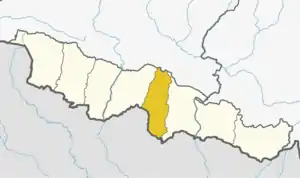Matihani, Mahottari
Matihani is a Municipality situated in Mahottari District of Nepal. The Municipality is well known for its historical significance and its way of celebrating any festival. It was formed in as a municipality in 2016 occupying current 9 sections (wards) from previous 9 former VDCs.[1] It occupies an area of 29.02 sq. km with a total population of 31,026.[2][3][4]

The second largest Laxmi Narayan temple of Nepal is located at the center of Matihani. The pond surrounding Laxmi Narayan temple which is commonly known as "Laxmi Narayan pond" is associated with the marriage ceremony of goddes s Sita and lord Rama according to the holy book(Ramayan) of hindu,The ceremony of sita "matkor" was held here.Currently the village has a government school and some small school but Damodar Academy (school in Parikauli) provides bus service to the students lifting the education system of the village.One of the famous school of mahottary district is here named "Shree Ram higher secondary school -8". The village is also home to one of the oldest sanskrit school of Nepal. [5]The Village has done tremendous development in terms of technology it has provided free WiFi hotspot across different locations of the village.
Historical Importance
First of all, Matihani is the place which is the gateway of Ramayana in Nepal. Why is it so?
In a traditional mithila marriage, Matkor ceremony is conducted when the groom comes to the bride place for marriage. Matihani which is located at the border was the place in Nepal where matkor of Mata Sita was conducted in the treta yuga. Bedi is a ritual where Mud is needed for the matkor ceremony, the annual weeding ceremony (Bibah Panchmi) which takes place every year at Janakpur, the mud is taken from the pond nearby of Swami Laxmi Narayan temple.
The king of Sen dynasty came and meet Tasmaniya baba who was meditating in the jungle of Matihani and asked how to get a son.The saint said to the king build a school and a mandir here and you wish would be successful. Just like the saint said the wishes of the king was fulfilled and he got a son and returned to Matihani and built the Sanskrit school and the Laxmi Narayan temple which is the oldest Mhath in Nepal .
MODERN TIME:-
In Matihani a very good working Clock Tower is Made by Matihani Nagarpalika, but no tourist come here as it is mata sita and shri ram was walked and done their wedding rituals although Matihani Nagarpalika is working hard to make Matihani a tourist attraction but no one knows this area.
YouTubers in Matihani:-
There are some YouTubers in Matihani Nagarpalika who make videos on gold working, Photography, Gaming, Comedy, Animation Dubbing etc in this most of them have very low no. Of subscribers and only few have a large no. Subscribers.Young YouTubers content are good but they not get viral or popular.
Schools and literacy in Matihani.
There are few small schools in Matihani but they also not have good teachers and classes children have to go either in Damodar Academy(Nepal) almost 10km from Matihani or Delhi Public school(India) Approx 4-5km from Matihani also they have to cross the border of Nepal and India.
Some children's goes to nearby Government school where they not get education good or better yet
Overall the literacy is good in Matihani but no one making it perfect.
Students have to go outer from this region for education after school for college also in Matihani the environment of education and skills are not good for studying.
Subham Raja
References
- "PM formally announces 744 local units operational". My Republica. Archived from the original on 13 August 2018. Retrieved 13 August 2018.
- "स्थानिय तह". 103.69.124.141. Archived from the original on 31 August 2018. Retrieved 1 September 2018.
- "Population Ward Level 753 Local Unit" (PDF). CBS. 2 June 2017. Archived from the original (PDF) on 27 January 2018. Retrieved 9 December 2018.
- Nepal, Government of Nepal (November 2012). ""National Population and Housing Census 2011 (Village Development Committee/Municipality)" (PDF). National Planning Commission. Archived from the original (PDF) on 5 October 2018. Retrieved 9 December 2018.
- "Nepal Census 2001", Nepal's Village Development Committees, Digital Himalaya, archived from the original on 12 October 2008, retrieved 15 November 2009.

